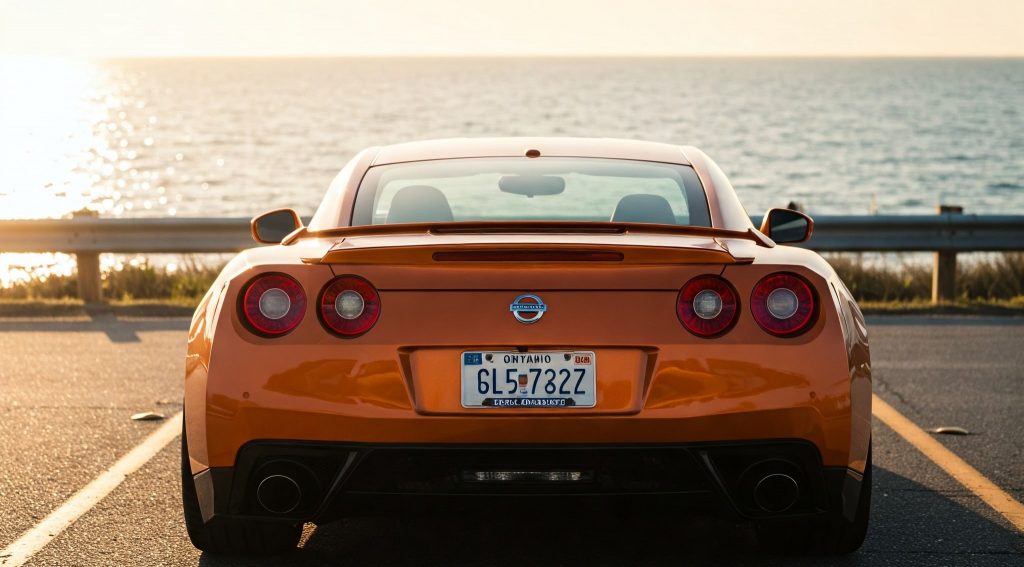Importing a car to the United States involves specific requirements depending on the vehicle’s age, origin, and purpose. For cars over 25 years old, the 25-Year Rule allows importation and registration for road use without meeting modern safety and emissions standards.
This rule, designed for collectors and enthusiasts, opens the door to unique and classic cars from around the world, according to the CBP. For cars under 25 years old, the Show and Display Rule offers a potential exception.
This pathway applies to vehicles with historical or technological significance that were never sold in the U.S. However, vehicles imported under this rule are limited in road use and must be approved by the National Highway Traffic Safety Administration, the NHTSA said.
For Canadian-registered vehicles frequently crossing the U.S. border, it’s essential to know that they are only allowed in the United States for one year without completing the formal import process.
After 365 days, U.S. authorities may seize the vehicle and either deport it or, in extreme cases, destroy it. To prevent this, ensure the importation process is completed within the allowed timeframe, the CBP said.
Additionally, vehicles must meet U.S. safety and emissions standards unless specific exemptions apply, according to the EPA.
To navigate the complexities of importing a vehicle, consider working with a customs broker or import specialist and ensure you have all required documents, such as the bill of sale and proof of ownership.
By understanding these regulations and utilizing resources like those provided by U.S. Customs and Border Protection and the NHTSA, you can make the process smoother and avoid costly mistakes.
One Factor That Simplifies Importation
If the vehicle you want to import is also sold in the United States, you may find the process slightly more straightforward. Many automakers, such as GM, Chrysler, and Ford, have production facilities in Canada that manufacture vehicles for the U.S. market.
For example, Ford produces models like the Flex and Edge in Ontario, while GM manufactures the Camaro and Impala in the same province, the CBP said. However, not all vehicles produced in Canada by these manufacturers automatically meet U.S. specifications, so it’s important to verify compliance.
To determine if a vehicle meets U.S. standards, check the manufacturer’s label, which indicates whether the car was intended for the U.S. market. This label is typically located on the door latch post, near the edge of the door, or at the hinge pillar, according to the NHTSA.
If the label confirms compliance with U.S. safety and emissions regulations, the import process may be more straightforward, though additional steps could still be required to finalize the importation.
Federalizing a Used Car from Canada
Not all Canadian vehicles comply with the standards set by the National Traffic and Motor Vehicle Safety Act or the Environmental Protection Agency’s (EPA) emission regulations. However, the process of modifying vehicles to meet these standards, known as federalization, is generally manageable.
Canada’s motor vehicle safety standards are largely similar to those in the United States, which is why the National Highway Traffic Safety Administration (NHTSA) provides blanket eligibility for many Canadian-certified vehicles to be imported.
Despite these similarities, some differences still exist. For instance, vehicles manufactured before updates to the Federal Motor Vehicle Safety Standards (FMVSS) may require modifications to meet U.S. regulations, the NHTSA said.
These adjustments might involve adding or modifying specific components, depending on the vehicle’s make and model. For Canadian-certified vehicles, many of these changes are straightforward, but the exact requirements depend on the year and specifications of the vehicle.
Connecting with online forums and groups specific to your vehicle can provide valuable insight from others who have navigated the same process. Additionally, researching the compliance of your vehicle at the start of the importation process can help you avoid unnecessary delays or complications, according to the EPA.
While many Canadian vehicles already meet U.S. standards, taking these preliminary steps ensures peace of mind and a smoother importation experience.
Can I Legally Import a Vehicle from Canada?
Importing vehicles from Canada is allowed for personal use, but it comes with a set of important requirements. The vehicle must comply with the Federal Department of Transportation (DOT) safety standards and meet the U.S. Environmental Protection Agency (EPA) emissions regulations.
If the vehicle does not meet these standards, the process of bringing it into compliance is known as federalization, which must be handled by a DOT Registered Importer, according to the National Highway Traffic Safety Administration.
Before proceeding with any purchase, it’s essential to ensure that the vehicle you are interested in has no liens, title issues, or theft records. A vehicle with unresolved issues could be problematic when crossing the border, potentially preventing it from being imported into the United States.
It’s critical to perform thorough checks to avoid unexpected complications after purchase, the U.S. Customs and Border Protection said.
To streamline the process and reduce potential obstacles, many buyers opt to work with a DOT Registered Importer, who can help ensure the vehicle is modified to meet U.S. standards. These professionals can also help navigate any regulatory requirements that might arise during the importation process.
Additionally, researching and verifying the vehicle’s status early can save time, money, and stress. Knowing the specific compliance needs of your vehicle ensures a smoother transition, helping you avoid costly delays or the possibility of being unable to import the car at all.
Importation can be a complex process, but by following the proper steps and leveraging resources like registered importers, it can be a seamless experience, the Environmental Protection Agency said.
If you’re uncertain about the process or simply want guidance, our team can assist you with every step of the way, from ensuring the vehicle meets U.S. standards to successfully bringing it across the border.
Utilize our convenient VIN check to ensure the vehicle’s status is clear before making your purchase.
How to Import a Vehicle from Canada in 7 Steps
- After completing the research discussed and confirming that your vehicle is eligible for importation, proceed to Canada to purchase the vehicle. Ensure you obtain a Bill of Sale that includes the VIN with your name as the purchaser.
- You will also need either the Manufacturer’s Statement/Certificate of Origin or the title and registration.
- Additionally, get a temporary license plate and an insurance card from the province where you make the purchase. Often, you can extend your U.S. insurance coverage to cover you while in Canada as well.
- You will need to pay a Goods and Services Tax (GST) on the car, but you should be exempt from Provincial Sales Tax (PST) if you are not a Canadian resident.
- Before heading to the border, have the car thoroughly cleaned and steam-sprayed. The U.S. Department of Agriculture requires that the undercarriage be completely free of any foreign soil, and you cannot predict what the previous owner may have left inside.
- Make sure your documents are in order before attempting to cross the border. You’ll need to fill out form CBP 7501 and some additional customs paperwork declaring your possessions, including the car. During this process, customs officials will inspect your car and check it against your paperwork. Expect this to take at least thirty minutes.
- Be prepared to pay all associated fees. When importing a car from Canada, you may encounter fees you haven’t seen before. The total cost will vary depending on the model of the vehicle you are importing.
What is the Cost of importing a Vehicle from Canada?
Importing a vehicle from Canada is generally comparable in cost to purchasing one in the United States. However, there are specific fees and taxes that you should be aware of to avoid any surprises.
A detailed breakdown of these costs can be found on the U.S. Customs and Border Protection (CBP) website, which provides comprehensive information on the import process, the U.S. Customs and Border Protection said.
For vehicles made in Canada or the U.S. or those imported for personal use, import duties (international trade taxes) are typically not applied. However, foreign-made vehicles and those imported for resale may incur duties. Here are the standard rates you can expect to pay:
- Autos: 2.5%
- Trucks: 25%
- Motorcycles: Up to 2.4%
These duties are based on the vehicle’s value and help ensure the trade process aligns with international agreements, according to the U.S. Customs and Border Protection.
In addition to import duties, there are other vehicle-specific fees that can add to the cost of importing a car from Canada. One of the most notable is the Air Conditioning Tax, which applies to cars equipped with A/C systems.
This tax can significantly increase the total importation cost, especially if the vehicle is a newer model or one with high-end features. The Air Conditioning Tax is designed to cover the environmental impact of refrigerants used in vehicle A/C systems, according to the Environmental Protection Agency.
If you’re importing a vehicle from certain Canadian provinces, you must also account for provincial sales tax. This applies when the vehicle is brought into the U.S. from areas like Nova Scotia, Newfoundland, New Brunswick, British Columbia, Labrador, or Ontario. The tax is typically collected when the vehicle crosses the border and can add an additional cost to your overall importation process, the U.S. Customs and Border Protection said.
Understanding these import duties and fees is essential for budgeting your vehicle importation from Canada. Researching all associated costs in advance and factoring in potential taxes and fees will ensure a smoother and more cost-effective process.
Once You Get Home
You have some further steps to take once you get back to the United States.
- Insure the vehicle in the U.S.
- Take your paperwork to the State DOT to register your vehicle. Prepare to pay the state taxes and applicable fees.
- You may need to get an emissions test before registration.
- In a few weeks, the tags and plates for the vehicle should arrive.
You Need a Title and License Plates
Dirt Legal provides titles, license plates, and registrations for imported vehicles through our Imported Vehicle Titling Service as well as domestic vehicles and just about anything else with wheels.
Pair with our LLC Formation Service for a tax-free experience, and add our Automatic Registration Renewal to keep things hassle-free and eliminate the DMV altogether.
We’re here to give you peace of mind whether you’re importing a car or buying one just down the street. Click the button below to learn more.
** We do not provide import/export services. This guide is for information only. **



